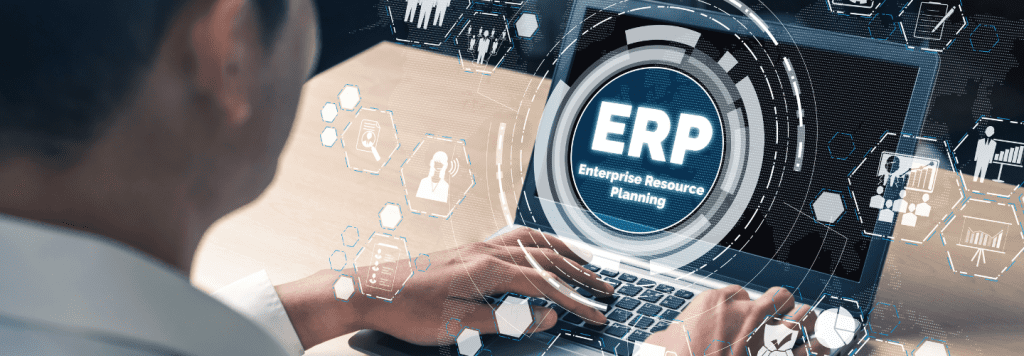
Every manufacturing company aims to stay ahead of the game in terms of managing resources effectively. One tool that can help you achieve this is Enterprise Resource Planning (ERP). But what is ERP and why is it important for the future of manufacturing? How does a business move through the process from selection of an ERP to implementation? In this article, you’ll get an overview of ERP, its benefits, and what it takes to select an ERP that is right for your business and get it implemented to streamline your manufacturing operations.
What is Enterprise Resource Planning?
Enterprise Resource Planning (ERP) is a software system that helps businesses manage their resources effectively. It integrates all business functions, such as finance, inventory management, production, sales, and human resources into a single system, providing a centralized view of your organization’s data. With ERP, you can automate routine tasks, streamline manufacturing processes, and improve visibility into your operations. ERP systems eliminate duplicate and manual data entry, which reduces errors, improves efficiency, and allows you to make better-informed decisions in real-time.
Choosing an ERP That’s Right For Your Business
Selecting an ERP system is no small decision – it can be exciting, complicated, and stressful. It is important to identify a project manager to help ease the selection and implementation process. There are three main steps that should be followed: Assess – what does the business need, Decide – choose a system, and Implement – go live using the system.
Assess – It is important to create a project team that typically includes an executive sponsor, a project manager, and representatives from the key departments that will use the system. This approach creates ownership and buy-in among the team while ensuring the project gets the resources it needs. Many businesses hire an external consultant or ERP implementation partner to provide expertise in design and configuration of the system.
One of the team’s main goals is to understand the current issues, including process inefficiencies and requirements for the ERP system. To help with this process, consider conducting a Needs and Wants Assessment. Key items to consider in this assessment are:
- Data Analytics
- Reporting Requirements
- User Experience / Ease of Use
- Automation Accessibility
- Future Business Growth
Decide –The decision process should evaluate two to three systems in a side-by-side comparison. Though costs are important, don’t make your decision based solely on cost. Make sure to review the pros and cons of each system – it is recommended that the following categories are included in the evaluation:
- Industry experience of each supplier
- Customization ability and requirements
- System flexibility
- Ease of use
- Reporting
- Implementation timeline
Lastly, before making a final decision, it is important to check references for each system. Not only should you be asking other clients what they like and dislike, ask about the implementation process. If possible, request an on-site visit or client demonstration. Asking other users about their experience is the best way to validate that you are choosing the right system for your business.
Implementation – Now the real work begins! Now that an ERP provider has been chosen, the next step is to develop an implementation plan and timeline. During the assessment phase, each department’s requirements were identified and the issues the system needs to solve are known. There are several steps included in the implementation phase of the process.
Design – Start by analyzing existing workflows and designing new, more efficient processes. Include users in this process, as they have the best understanding of current processes and what works and what doesn’t. This process will help identify what customization is required.
Development – In conjunction with the software vendor, configure the software to the business requirements. In parallel with software development, the team should start preparing training materials and documenting new processes. This is when you start planning data migration which can be complex. Migrating data often involves extracting, transforming and loading information from multiple sources. Bear in mind that each source may use different formats and may have duplicate or inconsistent information. The project team will need to determine how much historical information will be transferred.
Testing – Testing often occurs concurrently with development. System functions will be tested to identify issues and the team will need to develop fixes or make adjustments based on the testing results. Retesting will occur until the system is working properly. This phase should also encompass testing of the migrated data and include user training.
Deployment – This is what you have been striving toward! You will need to decide on the correct approach for your business. There are three common approaches to deployment which should be considered – all with varying levels of costs and risks.
- Big Bang – Deploy across all functions at the same time. This approach has the lowest cost, takes the least amount of time but has the highest risk of errors.
- Parallel – Run the new and old system simultaneously. This approach is the most expensive, has the lowest risk of errors but takes longer to deploy.
- Phased – Deploy 1-2 business functions at a time. This approach takes the longest time to deploy but has the lowest risk of errors. Costs associated with this phase are higher than the Big Bang, but lower than Parallel.
When deciding what deployment approach is best for your business, it is important to consider the complexity of your system, an acceptable timeline, the size of your business, the level of risk that the business is willing to take and costs.
Selecting and investing in the right ERP is key. We have an experienced manufacturing team to help with this process. Please reach out to us, we are happy to help with this important decision and process.
By Mindy Gallman (Lima Office)
